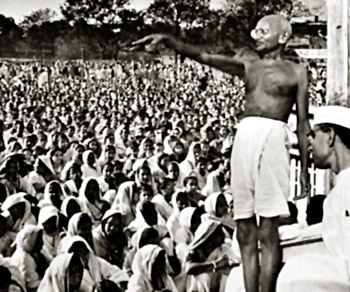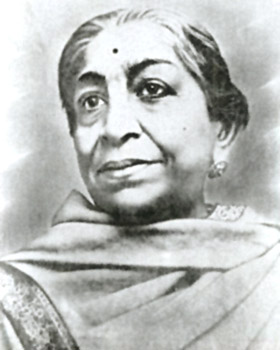 Women during Civil Disobedience Movement in Mumbai participated in large numbers. In fact when Mahatma Gandhi returned to politics he launched a civil disobedience campaign that brought large numbers of women into public life. Women`s participation in the civil disobedience movement of 1930-32 differed significantly from their earlier participation in the early 1920`s in terms of both their numbers as well as level of involvement.
Women during Civil Disobedience Movement in Mumbai participated in large numbers. In fact when Mahatma Gandhi returned to politics he launched a civil disobedience campaign that brought large numbers of women into public life. Women`s participation in the civil disobedience movement of 1930-32 differed significantly from their earlier participation in the early 1920`s in terms of both their numbers as well as level of involvement.
The picketing and demonstration by the women of Mumbai received more press attention than women`s activities in any other part of the country. The numbers of women marching were in the thousands and their pickets were organized and effective. That the women of Mumbai took the lead seemed natural given the cosmopolitan nature of the city, its transportation system, and the presence of Parsees and Christians, both communities supportive of female education. The large Gujarati population found the message of their fellow Gujarati, Gandhi, especially appealing. The women`s political organisation, the Rashtriya Stree Sangha (RSS), had remained under the presidency of Sarojini Naidu with Goshiben Naoroji Captain and Avantikabai Gokhale as vice-presidents. It stated its goals as Swaraj and women`s emancipation. By 1930, the leadership and structure of the RSS were sufficiently developed for it to generate a new, smaller organisation, the Desh Sevika Sangha (Women Serving the County) (DSS) whose members were ready for action.
Launch of Civil Disobedience Movement
 Gandhi began the civil disobedience campaign in March of 1930 with his 240-mile march from Ahmedabad to Dandi to make salt in defiance of the British monopoly. Women were very much involved and gathered at every stop to hear the Mahatma speak. The police reported meetings where there were thousands of women; in one case they estimated there were 10,000 women in the crowd. Gandhi talked to these village women about their patriotic duties- picketing liquor and toddy shops, boycotting taxed salt, and spinning and wearing khaddar. He noted that women`s patience and antipathy to violence made them particularly well suited for constructive work.
Gandhi began the civil disobedience campaign in March of 1930 with his 240-mile march from Ahmedabad to Dandi to make salt in defiance of the British monopoly. Women were very much involved and gathered at every stop to hear the Mahatma speak. The police reported meetings where there were thousands of women; in one case they estimated there were 10,000 women in the crowd. Gandhi talked to these village women about their patriotic duties- picketing liquor and toddy shops, boycotting taxed salt, and spinning and wearing khaddar. He noted that women`s patience and antipathy to violence made them particularly well suited for constructive work.
Gandhi was constructing a new ideal for Indian woman that rewrote passivity and self-suffering as strength. Gujarati women living in Mumbai responded to this message by forming an organization to plan and direct efforts to close shops selling foreign cloth.
Women`s Campaign in Mumbai
April 6, the anniversary of the Amritsar massacre, was chosen fort the formal breaking of the salt laws. A front line of seven people, including two women, Kamaladevi Chattopadhyay and Avantikabai Gokhale, were the first to step onto the beach, light fires, and boil sea water. The crowds that appeared were larger than anyone had expected. The Bombay Chronicle reported that thousands of Gujarati women had gathered at the Chowpatty Sea Face, collecting sea water in their brass and copper jugs. In the heart of the city, women volunteers picketed liquor shops and asked owners to close their doors and patrons to leave the premises. Other women sold salt on the streets, while still others went from house to house urging housewives to buy only Swadeshi products. The DSS had designed and supervised this campaign. In the early excitement of activity, women flocked to join this organization that soon had 560 members.
Demonstrations and picketing continued in Mumbai until 1931 when Gandhi was released from jail. During this time women proved their effectiveness in agitational politics. Merchants, faced with women picketing their shops, signed the pledge not to sell foreign cloth until an honourable peace had been arranged for the country. On the streets women joined men for flag-raisings and demonstrations.
The Desh Sevikas organized a number of demonstrations that grabbed headlines and inspired women all over India. Processions of one to two thousand women, accompanied by their children, were not unusual at this time. Even larger numbers came to listen to speeches about Swadeshi and freedom. The largest crowd celebrated Gandhi`s birthday and the release from prison of three of the most important women leaders: Lilavati Munshi, Perin Captain and Mrs. Lukanji. A mile-long chain of women, led by sevikas dressed in orange saris and carrying placards, numbered more than 5,000. Crowds of 10,000 assembled at both ends of this parade. These numbers could not be matched in other areas of India, but patriotic women everywhere emulated the spirit.



















